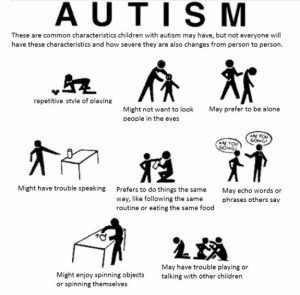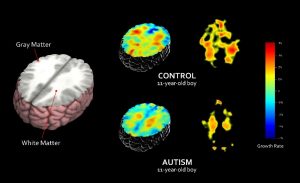Artstract created by T. Courier
Autism Characteristics
https://www.autismspectrumexplained.com/characteristics-for-kids.html
The current Diagnostic and Statistical Manual categorizes Autism as a spectrum. The benefit of using a spectrum model is it allows for differences in how it manifests including what symptoms exist and how severe they are. Some possible symptoms of Autism Spectrum Disorder (ASD) are social impairments, communication difficulties, repetitive movements, and obsessive interests. ASD is more common in boys and can be found in 1 out of 68 children. ASD is a disorder that is highly heritable and there are many genetic disorders that are linked to the development of ASD. There is still a lot that we do not know about ASD and no cure currently exists. https://www.ninds.nih.gov/Disorders/Patient-Caregiver-Education/Fact-Sheets/Autism-Spectrum-Disorder-Fact-Sheet
current Diagnostic and Statistical Manual categorizes Autism as a spectrum. The benefit of using a spectrum model is it allows for differences in how it manifests including what symptoms exist and how severe they are. Some possible symptoms of Autism Spectrum Disorder (ASD) are social impairments, communication difficulties, repetitive movements, and obsessive interests. ASD is more common in boys and can be found in 1 out of 68 children. ASD is a disorder that is highly heritable and there are many genetic disorders that are linked to the development of ASD. There is still a lot that we do not know about ASD and no cure currently exists. https://www.ninds.nih.gov/Disorders/Patient-Caregiver-Education/Fact-Sheets/Autism-Spectrum-Disorder-Fact-Sheet
Related Disorders
There are a number of genetic disorders that are related to ASD. One of these disorders is Fragile X Syndrome. Fragile X Syndrome occurs when there is a mutation on a gene (FMR1) that makes a protein (FMRP). This mutation means that FMRP is not formed. FMRP has a crucial role in regulating the translation of mRNA and can inhibit long term depression at the synapse. Long term depression occurs at the synapse when connections weaken and are pruned when they are no longer needed. https://www.ncbi.nlm.nih.gov/pmc/articles/PMC3722574/ The lack of FMRP can lead to an increase in immature dendritic spines which is characteristic of both Fragile X and ASD. There is significant symptom overlap between Fragile X and ASD and many people with Fragile X also have ASD. This makes Fragile X and the issues caused by a lack of FMRP a useful target to try to understand ASD. https://www.cdc.gov/ncbddd/fxs/facts.htm https://www.ncbi.nlm.nih.gov/pmc/articles/PMC4024105
What is Happening in the ASD Brain?
Many of the genes that are involved with the development of ASD involve the glutamate  pathway. The glutamate pathway is involved with the strength of synapses and when a lot of glutamate is present synapses are strengthened. https://flowpsychology.com/long-term-potentiation-definition-psychology/ The other important part of this process is that synapses that are not needed are pruned. However, in ASD this pruning does not happen. This may be due to overactive mTOR signaling. Autophagy is used to break down components of unneeded synapses. This process is inhibited by an overactivation of mTOR. The photo above shows the underdevelopment of a brain of a child with ASD and the lack of synaptic connection strength. The pruning that happens normally in childhood and adolescence is believed to allow for the rise of executive cognitive functioning, reasoning, and abstract thought. Many of these abilities are not present in people with ASD. Treatment with mTOR blockers may seem like an easy solution to rescue some of the cognitive deficits that are seen in ASD. Unfortunately, it is not that easy, mTOR signaling occurs throughout most of the body and cannot be target to only the areas that are affected by ASD. https://www.cell.com/action/showPdf?pii=S0896-6273%2814%2900651-5
pathway. The glutamate pathway is involved with the strength of synapses and when a lot of glutamate is present synapses are strengthened. https://flowpsychology.com/long-term-potentiation-definition-psychology/ The other important part of this process is that synapses that are not needed are pruned. However, in ASD this pruning does not happen. This may be due to overactive mTOR signaling. Autophagy is used to break down components of unneeded synapses. This process is inhibited by an overactivation of mTOR. The photo above shows the underdevelopment of a brain of a child with ASD and the lack of synaptic connection strength. The pruning that happens normally in childhood and adolescence is believed to allow for the rise of executive cognitive functioning, reasoning, and abstract thought. Many of these abilities are not present in people with ASD. Treatment with mTOR blockers may seem like an easy solution to rescue some of the cognitive deficits that are seen in ASD. Unfortunately, it is not that easy, mTOR signaling occurs throughout most of the body and cannot be target to only the areas that are affected by ASD. https://www.cell.com/action/showPdf?pii=S0896-6273%2814%2900651-5
Treatment Options
Further research is taking place to determine how mTOR can be targeted without causing damaging effects to other parts of the body. There are some treatments that currently exist for ASD. Early intervention treatments are helpful when a person is diagnosed with ASD as a young child. These treatments are focused on helping the child reach developmental milestones. Behavioral interventions can be used to reduce repetitive behaviors and to increase social skills. Sensory integration therapy can also be useful for people with ASD who are easily overwhelmed by sensory stimuli. Dietary interventions and supplements may also be necessary because many people with ASD experience gastrointestinal issues and others may refuse to eat certain types of food and miss out on necessary nutrients. Current treatments are focused on reducing the more severe symptoms of ASD and increasing social and life skills. https://www.cdc.gov/ncbddd/autism/treatment.html
